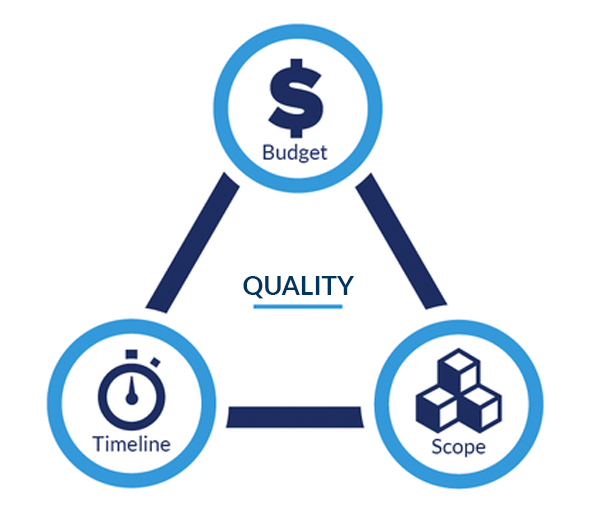
The biggest benefit of custom software development is right there in the name: it’s custom, built for your organization’s specific needs. More flexibility and the ability to include any feature you want–without the bulk of options you’ll never use–matter a lot.
Pretty much anything in software development is flexible, but every decision comes with a cost. This is what the software development triangle is all about.
What Is the Software Development Triangle?
The Iron Triangle, by its original name (also known as The Project Management Triangle or The Triple Constraint), is a model that dates back to the 1950s and explains the inherent constraints in project management.

Here’s what it depicts:
- Work quality is constrained by the budget, the timeline, and the scope.
- You can trade between constraints but you will never be constraint-free.
- If you change one side of the triangle, you will also have to change the others to compensate or work quality will suffer.
This is why it has “iron” in the name: You can’t change one constraint without impacting the others.

How the Iron Triangle Applies to Custom Software Development
“You can have it good, fast, or cheap. Pick two.” You’ve surely heard this before—it’s the informal way of explaining The Iron Triangle model. Blunt as it may sound, it’s true: Your budget influences the quality of the work, as do your deadlines and your scope:
- If you want to add more features, it’s going to cost more and it’s also going to take longer.
- If you want your software to be ready to use faster, you’re going to need to cut back on the number of features and may sacrifice quality if developers are rushed.
- If you have a smaller budget, you will have to cut back on the number or complexity of features.
There are challenges with this model as it applies to custom software, especially agile/scrum development. The budget and timeline may be fixed, within a range, and worthy of the “iron” classification. The scope, however, usually isn’t—nor should it be.
In custom software development, the scope should be flexible, otherwise, why bother with building something from scratch? Industry and market demands change fast and, when they do, so should your scope. After all, the purpose of creating your own software is to give you a competitive edge.
Knowing these constraints, learn about outsourcing custom development.
Read our guide on finding the right development partner.
Furthermore, time and money are objective truths, while scope can be subjective. “Done” to one party may be “not even close to done” to the other. This is where the relationship between consultants and clients can sometimes break down. When a scope isn’t understood to be the same by the client and the consultant, they can both feel like they are nickel and dimed.
In fact, a fixed, iron-clad scope can intensify this problem. A flexible scope with a prioritized backlog and transparent communication allows for navigating the complexity of custom software development, especially with an outsourced development partner.
Navigating Inflexibility with Flexible Approaches
Again, custom software development allows for flexibility and agility. After so many years in this field, we know that changing as you learn more is the key to success.
At Far Reach, flexibility is built into every project via the processes we use with clients and our team. We start with a minimum viable product (MVP), which gives our clients a chance to use their software as quickly as possible and generate some early ROI. We start with the highest-priority features and functionality and iterate throughout the whole process.
This approach ensures we’re always working on the most important elements of a custom system. We can add, remove, or reprioritize features as the client gets a better sense of how the application supports their business goals.
Experience has taught us that contingencies are another great way to foster flexibility. Per The Iron Triangle model, if the scope changes, something else will too—and that’s usually the budget. Contingencies allow us to deliver what the client needs, including potential additions discovered throughout the process, without having to use a formal “change order” and without compromising on the quality of work.
Because you can’t foresee every detail of a custom software system ahead of time, when something changes, something else has to give. The agile/scrum approach and our processes at Far Reach help us build custom software systems with quality as a top priority while allowing flexibility in scope. We work within the constraints of the software development triangle to give clients what they need and manage expectations along the way.
Does this flexible approach sound like something your
software strategy could benefit from?
Reach out, we’d love to learn how we can support you.